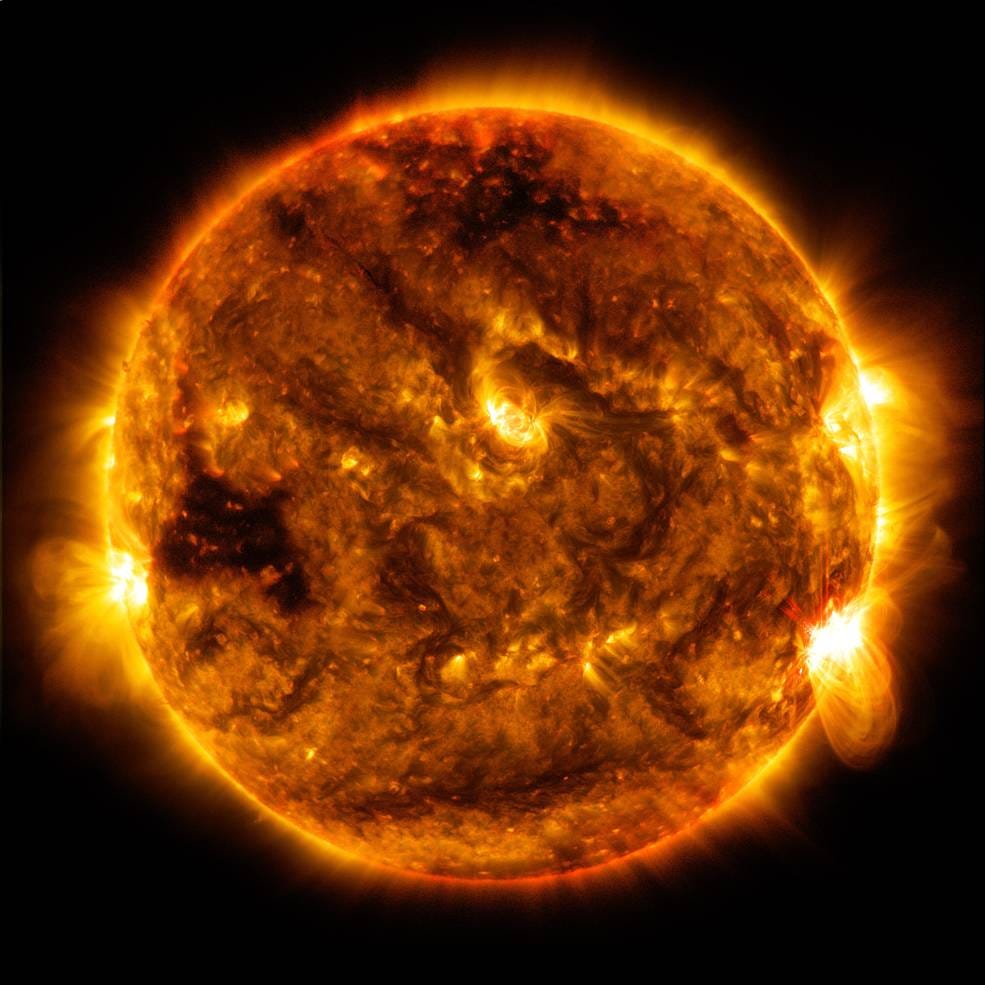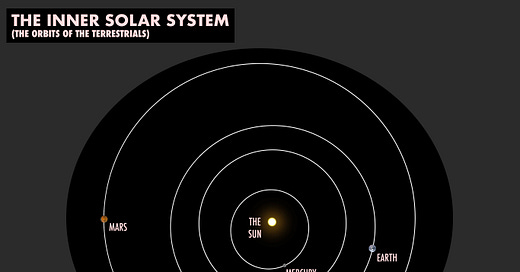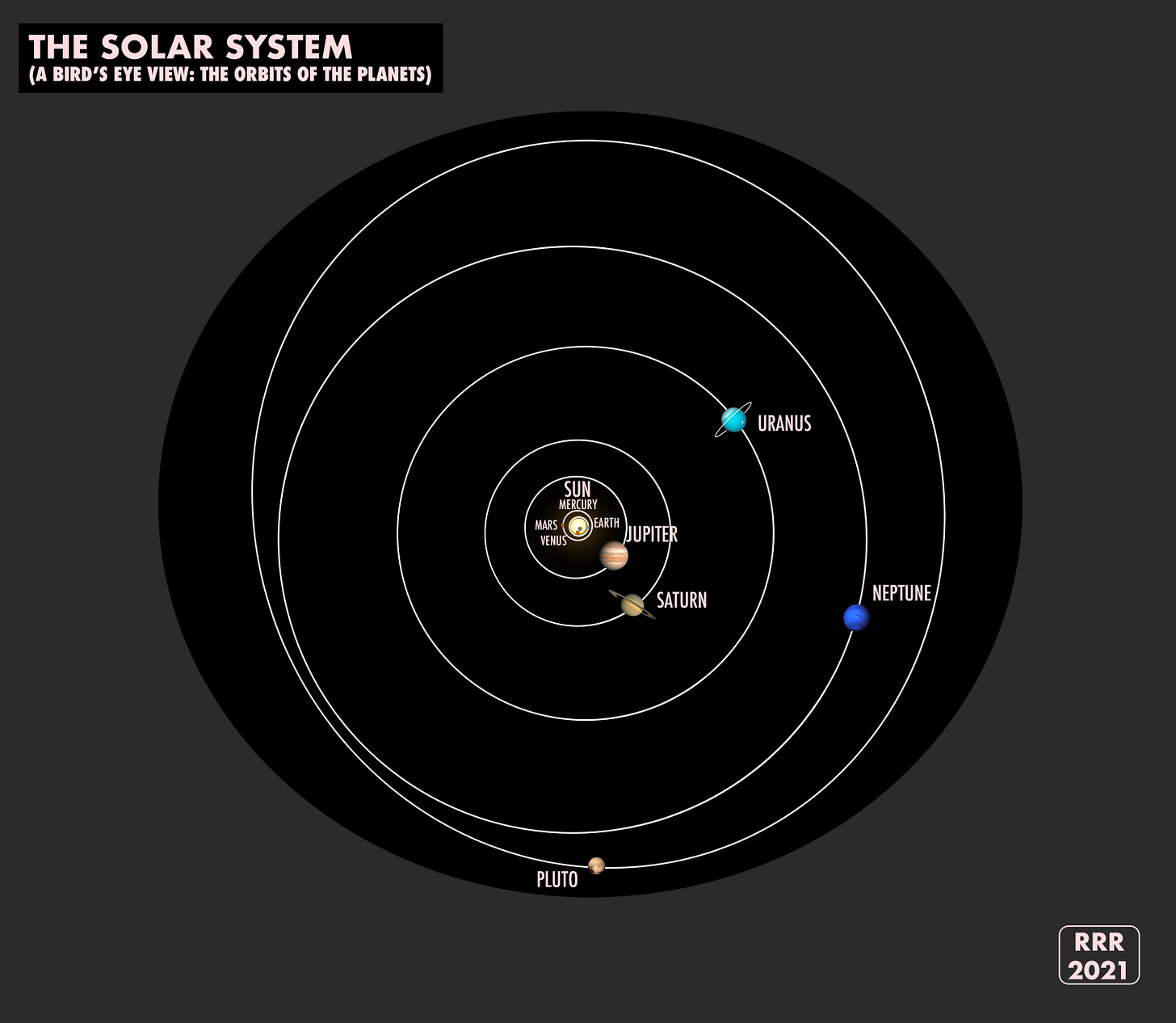Hello Earthlings.
Are you still there? Did I bring us too far out to the edge of the Universe, too soon? I was hoping to unhinge a brain or two, maybe bring a new point of view. Maybe I’ve prepared you, slightly, for what’s more to come. I’m bringing us back home this week, to our very own solar system.
I hope you will find equal parts wonder and comfort as we take a little gander across our home system where the only star that matters is the sun and although you will probably bemoan my mention of interplanetary dust, and wow do we have some gas giants to discuss… I promise you, we won’t run into anything like supermassive black holes, distant light echoes, broken star arms, gravitational waves, or ultragiant stars.
We don’t even have to travel a single light-year(!) - the distance from the sun to the outer edges of our solar system is under… ok wait no…the edges of our solar system might extend all the way to about 1.6 light-years from the Sun. But it only takes sunlight 8.3 minutes to reach the Earth and 5.5 hours to reach Pluto! That should reassure you!(?)
We’re going very slowly, too. There is a lot to look at in our planetary neighborhood! This volume will be a three-part-er. We’re only going as far out as about Mars in this first part, ok?(!) The second part will take us from the asteroid belt though the gas giants Jupiter, Saturn and their moons. The third and final part will bring us to that 1.6 light-year distant edge of the solar system and back around to the home star - Sun.
Are you ready?
let’s go
volume (7.1):
Our home stellar system: part 1(!)
A very quick introduction to the Solar System
The Solar System (or a stellar system) formed 4.6 billion years ago when the baby Sun collapsed from a giant nursery cloud of dust and gas. Most of the solar system’s mass lies within the Sun. The Sun’s nursery cloud also birthed all 8 of the planets: the four smaller inner system planets - Mercury, Venus, Earth and Mars (the terrestrial planets), and the four outer system planets - Jupiter, Saturn, Uranus and Neptune (the gas giants and the ice giants). All 8 planets have almost circular orbits that lie within a nearly flat disc in space.
Our solar system also contains smaller objects (like Pluto!) you might not have heard of. There is the asteroid belt, which lies between the orbits of Mars and Jupiter, that contains mostly objects composed of rock and metal like terrestrial planets (such as Earth). Within the asteroid belt, lives the dwarf planet Ceres. Beyond the orbit of Neptune lives the Kuiper belt where many so-called trans-Neptunian-Objects (TNOs) are found. Pluto as well as Haumea, Makemake, and Eris all live in the space past Neptune (although Pluto does technically come closer to the sun than Neptune in its orbit for 20 of every 248 years…). And let’s not forget the moons! All the planets (except Mercury and Venus) and the dwarf planets have at least one moon. These moons are natural satellites that orbit their home planets.
It is understood that everything in the solar system (with the exception of, naturally, interstellar visitors passing through) was formed of the same nursery cloud of dust and gas in space 4.6 billion years ago. Time capsules from earlier eras of the solar system are all around us, we just haven’t reached them all yet.
And now… without further ado…
The Sun ☉ [the home star]:

Contrary to the first thinkers of the topic (see the geocentric model), the Sun lies at the center of our system. The Sun (and its system) formed 4.6 billion years ago when the baby sun collapsed of a giant nursery cloud of dust and gas.
The Sun, along with all the celestial objects controlled by its gravitational grasp that we are about to cover, is located in the Milky Way galaxy. The Sun is specifically part of a spiral arm called the Orion Spur, from there our stellar system orbits the center of the Milky Way. Our stellar system is moving at an average velocity of 450,000 mph around the center of the galaxy. Despite this speed it takes us oh just about 230 million years to make one complete orbit around our Milky Way home galaxy(!).
Most of the Solar System’s mass lies within the Sun. The Sun’s atomic mass is currently composed of 73.46% Hydrogen, 24.85% Helium, and less than 1% Oxygen, Carbon, Iron, Neon, Nitrogen, Silicon, Magnesium and Sulphur. Its surface temperature averages 5,600˚C, while its core can reach 15 million C˚, which is sufficient to sustain thermonuclear fusion (converting hydrogen into helium).
Read the full series [our solar system]: the Sun - coming soon right HERE
Hopping, skipping, sashaying onto…
Mercury ☿ [ 1st planet from the sun]:

terrestrial planet (made mostly of rock)
orbit averages 36 million miles from the sun (3.2 light-minutes)
1 day on Mercury lasts 176 earth days, 1 year on Mercury lasts 88 earth days. Yes you read that correctly, the weird tiny planet closest to the sun goes around its orbit faster than it spins!
gravity on surface is 38% that of Earth
no moons
Robot Visitors:
NASA's Mariner 10 was the first to fly by Mercury (first to ever study the planet). NASA's MESSENGER was the first to orbit Mercury. ESA and JAXA's BepiColombo is on its way to orbit Mercury as we speak(!).
Read the full series [our solar system]: Mercury - coming soon right HERE
Venus ♀ [2nd planet from the sun]:
terrestrial planet (made mostly of rock)
orbit averages 67 million miles from the Sun (6.05 light-minutes)
1 day on Venus lasts 243 Earth days, 1 year on Venus lasts 225 Earth days. Yes you read that correctly, the second planet closest to the sun also goes around its orbit slightly faster than it spins. Not as peculiarly as Mercury, but Venus is weird too because its axis is nearly upside down and it rotates the opposite way of every other planet in the system!
gravity on surface is 91% that of Earth
no moons
Robot Visitors:
Many have flown-by Venus (Galileo, Cassini, MESSENGER to name a few) but the longest any probe has survived the surface of Venus’s crushing heat and air is just a little over two hours. That title is held by Venera 13 (a Soviet Union era probe from the 80’s). The last probe to land on Venus was Vega 2 which lasted only 52 minutes. NASA has just selected 2 different missions to Venus as part of their Discovery Program, each is expected to launch in the 2028-2030 timeframe:
Read the full series [our solar system]: Venus - coming soon right HERE
Earth 🜨 [3rd planet from the sun]:

terrestrial planet (made mostly of rock)
orbit averages 92.6 million miles from the Sun (8.3 light-minutes)
1x moon (the Moon)
Earth-Studying Satellites:
Honestly, way too many to list here you just have to go check them all out please. Between all the nations on Earth, there are more than 150 satellites studying Earth today(!).
Read the full series [our solar system]: Earth - coming soon right HERE
Mars ♂ [4th planet from the sun]:

terrestrial planet (made mostly of rock)
orbit averages 141.6 million miles from the sun (12.6 light-minutes)
1 day on Mars is roughly 37 minutes longer than an Earth day, 1 year on Mars lasts 687 Earth days.
gravity on surface is 38% that of Earth
Robot Visitors:
Mars is the second best explored planet in the solar system after our home planet, Earth. Since 1971 when NASA’s Mariner 9 first successfully reached orbit around Mars; there have been 10 successful missions to orbit the planet and 10 successful mission landings (landers and or rovers)! Right now, there are three active rovers and one martian helicopter operating on the surface of Mars oh and don’t forget about the inSight lander...
Read the full series [our solar system]: Mars - coming soon right HERE
Did you know that all the terrestrial planets likely were formed with the building blocks for life but because of various factors (read: trauma) in their childhoods - mostly due to the evolving young Sun getting hotter and hotter and more energetic, oh and of course also Jupiter and its big @$$ playing with gravity - only Earth has sustained just the right conditions for water to remain on the planet for millions of years. Allowing for life to exist and evolve with it.
We will pick up right here next time moving on to the asteroid belt which lies between the orbits of Mars and Jupiter. Until then…
Don’t Miss Out (!)
It’s getting easier to get a glimpse of Venus this week. If you look towards the horizon/setting sun in the west you can catch Venus looking like the brightest star in the sky until it sets soon after 8pm pst this week.
The Moon seems to slowly move away from Jupiter and Saturn in the night sky this week but the two giant planets continue to dance together pretty high across the southern sky all night.
Hey Earthlings, before we say goodbye… I’ve opened the paid subscription option on here. If you enjoyed this really quick run-through of our home stellar system (or any of the other volumes available here), consider becoming a paid subscriber for access to the complete codex of cosmic details. Behind the paywall lives the ever deeper dive into each celestial detail covered in the main (free) volumes. I am starting with a series [our stellar system] of 12 posts (to be continuously updated) where I tell the full story of the sun, each the of the planets, the asteroids/the comets, the dwarf planets, the entire solar system in astronomical detail. Tons of original infographics and visualizations, as well as a fully comprehensive link compendium for each topic so you can continue to build even more upon your cosmic knowledge should you be so inspired to do so! Want to know more about variable stars? Have burning questions about black holes? First of all, let’s chat. Leave a comment somewhere - ask a question! But also considering becoming a paid subscriber and together we can fully faceplant into the void.
And if you really loved it. Maybe you’ll share space matter(s) too(?)
“When you change the way you look at things, the things you look at change.” - Max Planck






